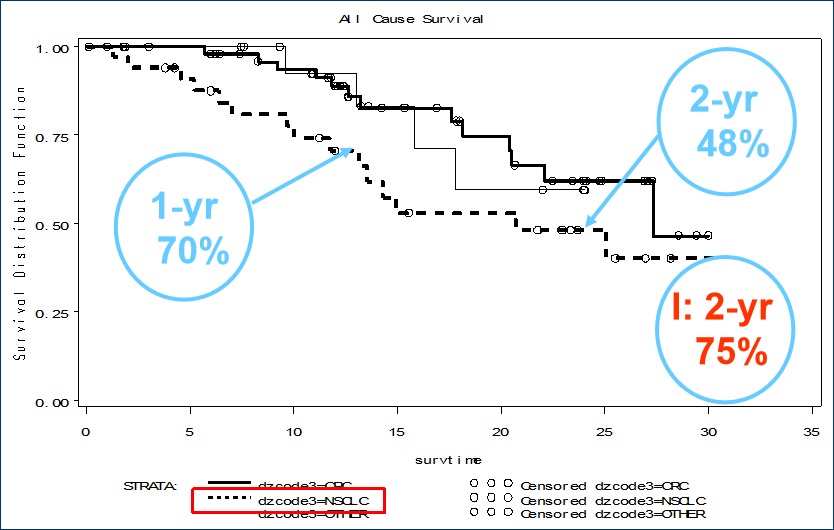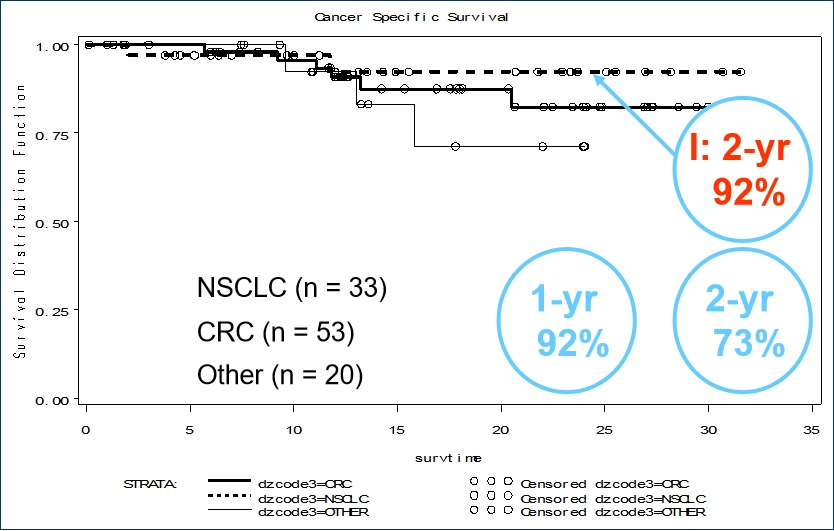Radiofrequency
Ablation of
Pulmonary
TUmors
Response
Evaluation (
RAPTURE) Trial

Riccardo Lencioni, MD, Pisa, Italy

Lencioni et al. Lancet Oncol 2008; 9:621-628.
Between July 1, 2001, and Dec 10, 2005, a series of 106 patients with 183 lung tumours that were 3.5 cm in diameter or smaller (mean 1.7 cm [SD 1.3]) were enrolled in a prospective, intention-to-treat, single-arm, multicentre clinical trial from seven centres in Europe, the USA, and Australia.
|
|
NSCLC (n = 33) |
CRC (n = 53) |
Other (n = 20) |
Total (n = 106) |
|
Gender (F : M) |
8 : 25 |
16 : 37 |
12 : 8 |
36 : 70 |
|
Age(median) |
67 |
63 |
70 |
66 |
Mean # Tumors
Total |
1.2 (0.4)
38 |
2.2 (1.6)
119 |
1.3 (0.7)
26 |
1.7 (1.3)
183 |
Mean Tumor Size (cm)
Range (cm) |
2.2 (0.7)
0.7 – 3.0
|
1.4 (0.7)
0.5 – 3.4
|
2.1 (0.7)
0.8 – 3.4
|
1.7 (0.8)
0.5 – 3.4
|
Primary endpoints were technical success (defined as correct placement of the ablation device into all tumour targets with completion of the planned ablation protocol)、: Correct placement of the ablation device into the target tumour with completion of the planned treatment protocol was feasible in 105 (99%) of 106 patients.

Overall survival was 70% (95% CI 51-83%) at 1 year and 48% (30-65%) at 2 years in patients with NSCLC。Patients with stage I NSCLC (n=13) had a 2-year overall survival of 75% (45-92%) and a 2-year cancer-specific survival of 92% (66-99%)
Cancer-specific Survival(肿瘤特异性生存率”,是按照肿瘤的特征分类后计算的生存率,用来评估分类标准对生存率的影响)

Cancer-specific survival was 92% (78-98%) at 1 year and 73% (54-86%) at 2 years in patients with NSCLC, Patients with stage I NSCLC (n=13) had a 2-year overall survival of 75% (45-92%) and a 2-year cancer-specific survival of 92% (66-99%)
RFA Lung Preservation
Nonsmall cell lung carcinoma : RAPTURE trial1 (n = 22)
|
|
baseline |
1 month |
3 months |
6 months |
12 months |
|
FEV, L |
1.9 (0.9) |
1.7 (1.1) |
1.7 (0.9) |
1.6 (0.9) |
1.5 (0.7) |
|
FEV %, predicted |
68.8 (26.9) |
65.3 (24.6) |
71.0 (27.2) |
62.5 (18.5) |
63.4 (20.7) |
|
FVC, L |
2.9 (0.9) |
2.6 (1.1) |
2.8 (0.8) |
2.7 (0.9) |
2.7 (1.0) |
|
FVC %, predicted |
82.4 (18.1) |
77.2 (16.2) |
82.0 (19.5) |
76.7 (12.4) |
74.5 (18.3) |
Percutaneous radiofrequency ablation yields high proportions of sustained complete responses in properly selected patients with pulmonary malignancies, and is associated with acceptable morbidity. Randomised controlled trials comparing radiofrequency ablation with standard non-surgical treatment options are warranted.

